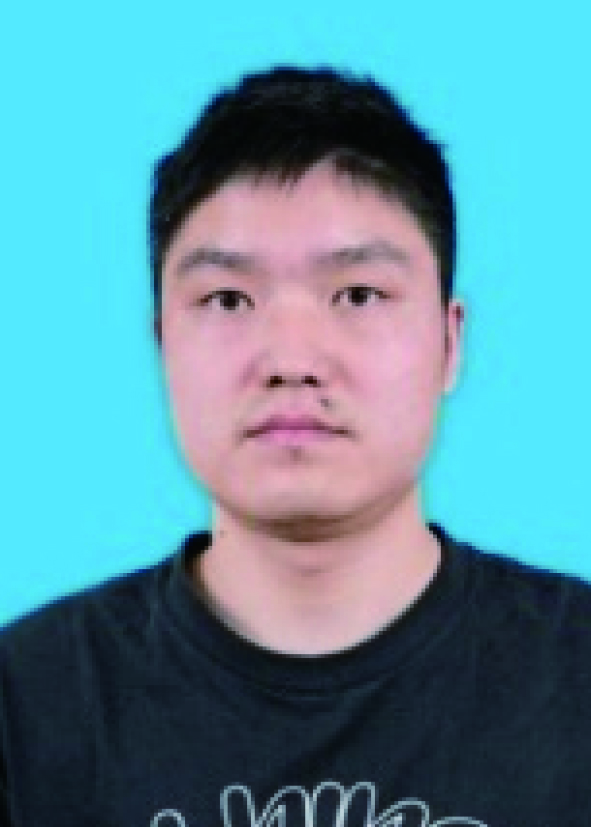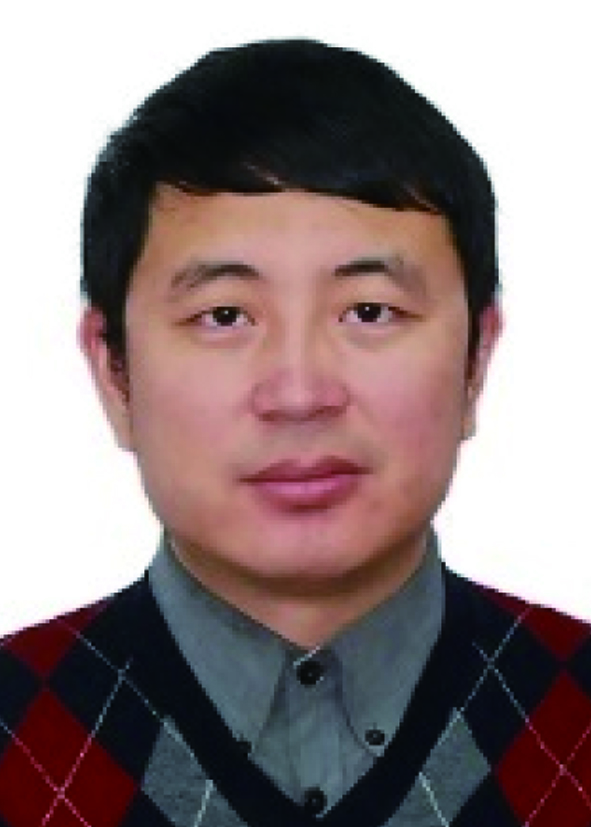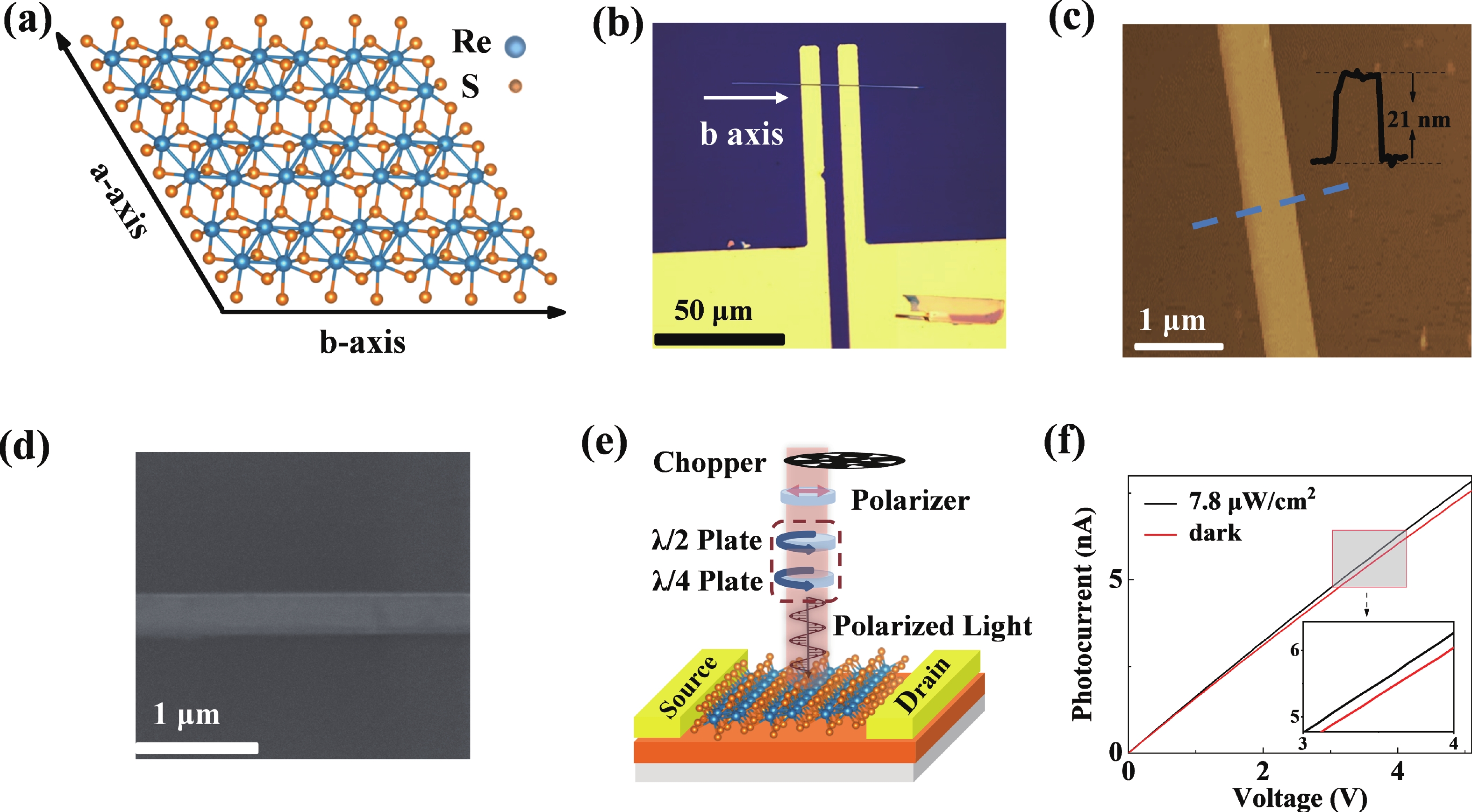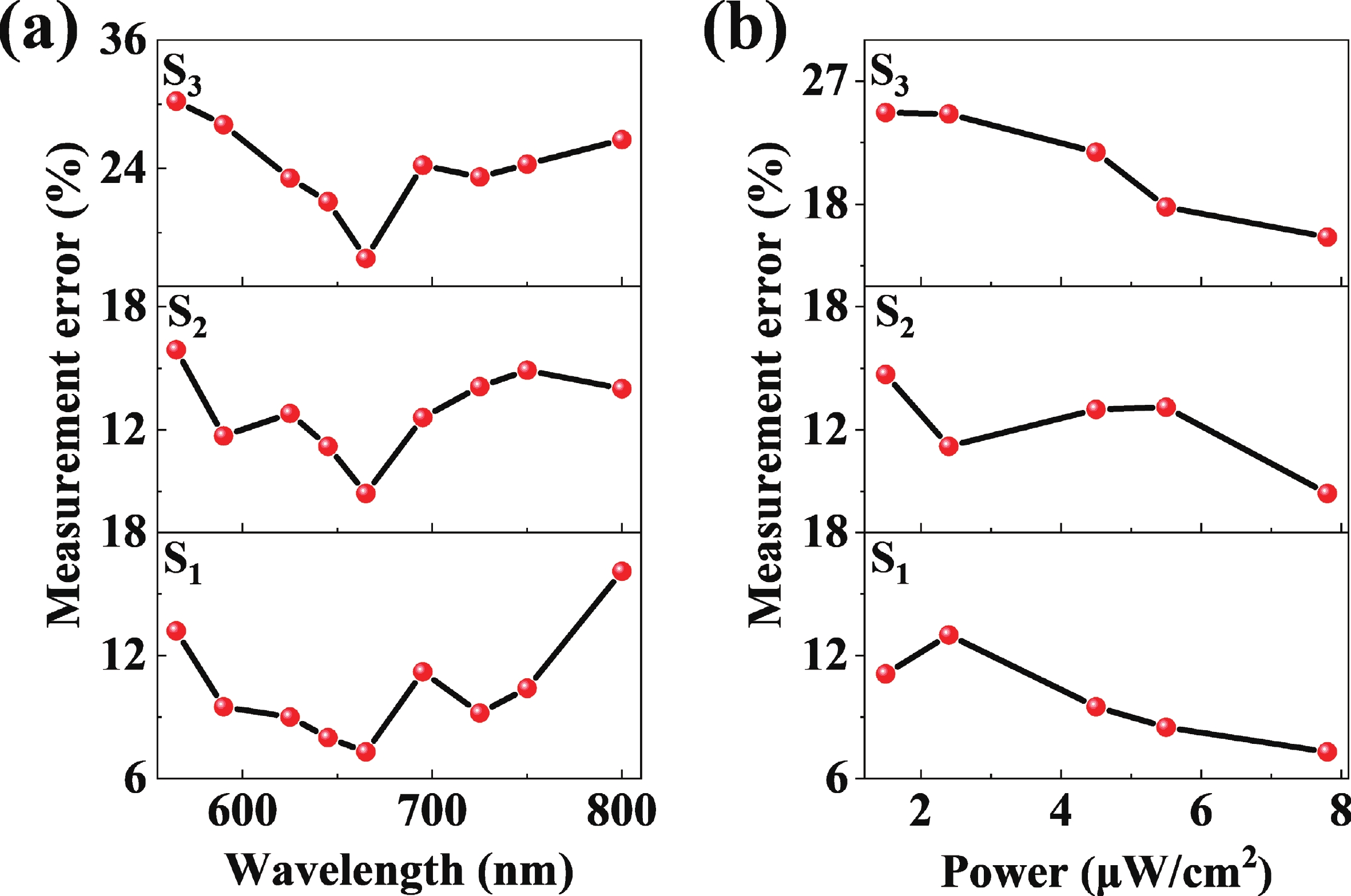| Citation: |
Tinghao Lin, Wendian Yao, Zeyi Liu, Haizhen Wang, Dehui Li, and Xinliang Zhang. Broadband full-stokes polarimeter based on ReS2 nanobelts[J]. Journal of Semiconductors, 2025, 46(3): 032702. doi: 10.1088/1674-4926/24080023
****
T H Lin, W D Yao, Z Y Liu, H Z Wang, D H Li, and X L Zhang, Broadband full-stokes polarimeter based on ReS2 nanobelts[J]. J. Semicond., 2025, 46(3), 032702 doi: 10.1088/1674-4926/24080023
|
Broadband full-stokes polarimeter based on ReS2 nanobelts
DOI: 10.1088/1674-4926/24080023
CSTR: 32376.14.1674-4926.24080023
More Information-
Abstract
Full-Stokes polarimeters can detect the polarization states of light, which is critical for the next-generation optical and optoelectronic systems. Traditional full-Stokes polarimeters are either based on bulky optical systems or complex metasurface structures, which cause the system complexity with unessential energy loss. Recently, filterless on-chip full-Stokes polarimeters have been demonstrated by using optical anisotropic materials which are able to detect the circularly polarized light. Nevertheless, those on-chip full-Stokes polarimeters have either the limited detection wavelength range or relatively poor device performance that need to be further improved. Here, we report the high performance broadband full-Stokes polarimeters based on rhenium disulfide (ReS2). While the anisotropic structure of the ReS2 introduces the in-plane optical anisotropy for linearly polarized light (LP) detection, Schottky contacts formed by the ReS2−Au could break the symmetry, which can detect circularly polarized (CP) light. By building a proper model, all four Stokes parameters can be extracted by using the ReS2 nanobelt device. The device delivers a photoresponsivity of 181 A/W, a detectivity of 6.8 × 1010 Jones and can sense the four Stokes parameters of incident light within a wide range of wavelength from 565−800 nm with reasonable average errors. We believe our study provides an alternative strategy to develop high performance broadband on-chip full-Stokes polarimeters.-
Keywords:
- broadband,
- states of polarization,
- ReS2,
- full-Stokes polarimeter
-
References
[1] Rubin N A, D’Aversa G, Chevalier P, et al. Matrix Fourier optics enables a compact full-Stokes polarization camera. Science, 2019, 365, eaax1839 doi: 10.1126/science.aax1839[2] He S, Wang X, Xia R Q, et al. Polarimetric infrared imaging simulation of a synthetic sea surface with Mie scattering. Appl Opt, 2018, 57, B150 doi: 10.1364/AO.57.00B150[3] Shao X Z, Zheng W, Huang Z W. Polarized near-infrared autofluorescence imaging combined with near-infrared diffuse reflectance imaging for improving colonic cancer detection. Opt Express, 2010, 18, 24293 doi: 10.1364/OE.18.024293[4] Niu Y Y, Zhou X, Gao W, et al. Interfacial engineering of In2Se3/h-BN/CsPb(Br/I)3 heterostructure photodetector and its application in automatic obstacle avoidance system. ACS Nano, 2023, 17, 13760 doi: 10.1021/acsnano.3c03319[5] Talmage D A, Curran P J. Remote sensing using partially polarized light. Int J Remote Sens, 1986, 7, 47 doi: 10.1080/01431168608954660[6] Long M S, Gao A Y, Wang P, et al. Room temperature high-detectivity mid-infrared photodetectors based on black arsenic phosphorus. Sci Adv, 2017, 3, e1700589 doi: 10.1126/sciadv.1700589[7] Ahn J, Kyhm J H, Kang H K, et al. 2D MoTe2/ReS2 van der waals heterostructure for high-performance and linear polarization-sensitive photodetector. ACS Photonics, 2021, 8, 2650 doi: 10.1021/acsphotonics.1c00598[8] Balthasar Mueller J P, Leosson K, Capasso F. Ultracompact metasurface in-line polarimeter. Optica, 2016, 3, 42 doi: 10.1364/OPTICA.3.000042[9] Berry H G, Gabrielse G, Livingston A E. Measurement of the Stokes parameters of light. Appl Opt, 1977, 16, 3200 doi: 10.1364/AO.16.003200[10] Li X S, Wang H, Xu X M, et al. Mid-infrared full-Stokes polarization detection based on dielectric metasurfaces. Opt Commun, 2021, 484, 126690 doi: 10.1016/j.optcom.2020.126690[11] Lin Z J, Dadalyan T, Bélanger-de Villers S, et al. Chip-scale full-stokes spectropolarimeter in silicon photonic circuits. Photon Res, 2020, 8, 864 doi: 10.1364/PRJ.385008[12] Lin Z J, Rusch L, Chen Y X, et al. Chip-scale, full-Stokes polarimeter. Opt Express, 2019, 27, 4867 doi: 10.1364/OE.27.004867[13] Basiri A, Chen X H, Bai J, et al. Nature-inspired chiral metasurfaces for circular polarization detection and full-Stokes polarimetric measurements. Light: Sci Appl, 2019, 8, 78 doi: 10.1038/s41377-019-0184-4[14] Dai M J, Wang C W, Qiang B, et al. On-chip mid-infrared photothermoelectric detectors for full-Stokes detection. Nat Commun, 2022, 13, 4560 doi: 10.1038/s41467-022-32309-w[15] Zhao Y J, Qiu Y C, Feng J G, et al. Chiral 2D-perovskite nanowires for stokes photodetectors. J Am Chem Soc, 2021, 143, 8437 doi: 10.1021/jacs.1c02675[16] Fang C, Li J Z, Zhou B X, et al. Self-powered filterless on-chip full-stokes polarimeter. Nano Lett, 2021, 21, 6156 doi: 10.1021/acs.nanolett.1c01729[17] Ma J Q, Fang C, Liang L H, et al. Full-stokes polarimeter based on chiral perovskites with chirality and large optical anisotropy. Small, 2021, 17, 2103855 doi: 10.1002/smll.202103855[18] Fang C, Wang H Z, Shen H Z, et al. High-performance photodetectors based on lead-free 2D ruddlesden-popper perovskite/MoS2 heterostructures. ACS Appl Mater Inter, 2019, 11, 8419 doi: 10.1021/acsami.8b20538[19] Zhong F, Ye J F, He T, et al. Substitutionally doped MoSe2 for high-performance electronics and optoelectronics. Small, 2021, 17, e2102855 doi: 10.1002/smll.202102855[20] Lan H Y, Hsieh Y H, Chiao Z Y, et al. Gate-tunable plasmon-enhanced photodetection in a monolayer MoS2 phototransistor with ultrahigh photoresponsivity. Nano Lett, 2021, 21, 3083 doi: 10.1021/acs.nanolett.1c00271[21] Zhou Y, Luo J J, Zhao Y, et al. Flexible linearly polarized photodetectors based on all-inorganic perovskite CsPbI3 nanowires. Adv Opt Mater, 2018, 6, 1800679 doi: 10.1002/adom.201800679[22] Yao J D, Yang G W. Flexible and high-performance all-2D photodetector for wearable devices. Small, 2018, 14, e1704524 doi: 10.1002/smll.201704524[23] Zhao T G, Guo J X, Li T T, et al. Substrate engineering for wafer-scale two-dimensional material growth: Strategies, mechanisms, and perspectives. Chem Soc Rev, 2023, 52, 1650 doi: 10.1039/D2CS00657J[24] Zhao T G, Chen Y, Xu T F, et al. Topological insulator Bi2Se3 heterojunction with a low dark current for midwave infrared photodetection. ACS Photonics, 2024, 11, 2450 doi: 10.1021/acsphotonics.4c00347[25] Wang Z, Tan C H, Peng M, et al. Giant infrared bulk photovoltaic effect in tellurene for broad-spectrum neuromodulation. Light Sci Appl, 2024, 13, 277 doi: 10.1038/s41377-024-01640-w[26] Ahn J, Ko K, Kyhm J H, et al. Near-infrared self-powered linearly polarized photodetection and digital incoherent holography using WSe2/ReSe2 van der waals heterostructure. ACS Nano, 2021, 15, 17917 doi: 10.1021/acsnano.1c06234[27] Zhang E Z, Wang P, Li Z, et al. Tunable ambipolar polarization-sensitive photodetectors based on high-anisotropy ReSe2 nanosheets. ACS Nano, 2016, 10, 8067 doi: 10.1021/acsnano.6b04165[28] Yang Y S, Liu S C, Yang W, et al. Air-stable In-plane anisotropic GeSe2 for highly polarization-sensitive photodetection in short wave region. J Am Chem Soc, 2018, 140, 4150 doi: 10.1021/jacs.8b01234[29] Xin Y, Wang X X, Chen Z, et al. Polarization-sensitive self-powered type-II GeSe/MoS2 van der waals heterojunction photodetector. ACS Appl Mater Interfaces, 2020, 12, 15406 doi: 10.1021/acsami.0c01405[30] Wu D, Xu M M, Zeng L H, et al. In situ fabrication of PdSe2/GaN Schottky junction for polarization-sensitive ultraviolet photodetection with high dichroic ratio. ACS Nano, 2022, 16, 5545 doi: 10.1021/acsnano.1c10181[31] Li G, Yin S Q, Tan C Y, et al. Fast photothermoelectric response in CVD-grown PdSe2 photodetectors with In-plane anisotropy. Adv Funct Mater, 2021, 31, 2104787 doi: 10.1002/adfm.202104787[32] Liu F C, Zheng S J, He X X, et al. Highly sensitive detection of polarized light using anisotropic 2D ReS2. Adv Funct Mater, 2016, 26, 1169 doi: 10.1002/adfm.201504546[33] Nagler P, Plechinger G, Schüller C, et al. Observation of anisotropic interlayer Raman modes in few-layer ReS2. Phys Status Solidi RRL, 2016, 10, 185 doi: 10.1002/pssr.201510412[34] Sim S, Lee D, Noh M, et al. Selectively tunable optical Stark effect of anisotropic excitons in atomically thin ReS2. Nat Commun, 2016, 7, 13569 doi: 10.1038/ncomms13569[35] McCreary A, Simpson J R, Wang Y X, et al. Intricate resonant Raman response in anisotropic ReS2. Nano Lett, 2017, 17, 5897 doi: 10.1021/acs.nanolett.7b01463[36] Rahman M, Davey K, Qiao S Z. Advent of 2D rhenium disulfide (ReS2): Fundamentals to applications. Adv Funct Mater, 2017, 27, 1606129 doi: 10.1002/adfm.201606129[37] Lin T H, Yao W D, Liu Z Y, et al. High performance broadband full linear polarimeter based on ReS2 nanobelts. Adv Opt Mater, 2023, 11, 2300345 doi: 10.1002/adom.202300345[38] Gao S, Wang Z Q, Wang H D, et al. Graphene/MoS2/graphene vertical heterostructure-based broadband photodetector with high performance. Adv Mater Interfaces, 2021, 8, 2001730 doi: 10.1002/admi.202001730[39] Zhang K, Fang X, Wang Y L, et al. Ultrasensitive near-infrared photodetectors based on a graphene–MoTe2–graphene vertical van der waals heterostructure. ACS Appl Mater Interfaces, 2017, 9, 5392 doi: 10.1021/acsami.6b14483[40] Dhara S, Mele E J, Agarwal R. Voltage-tunable circular photogalvanic effect in silicon nanowires. Science, 2015, 349, 726 doi: 10.1126/science.aac6275[41] Quereda J, Hidding J, Ghiasi T S, et al. The role of device asymmetries and Schottky barriers on the helicity-dependent photoresponse of 2D phototransistors. NPJ 2D Mater Appl, 2021, 5, 13 doi: 10.1038/s41699-020-00194-w[42] Xiong Y F, Wang Y S, Zhu R Z, et al. Twisted black phosphorus-based van der Waals stacks for fiber-integrated polarimeters. Sci Adv, 2022, 8, eabo0375 doi: 10.1126/sciadv.abo0375[43] Li J Z, Wang J, Ma J Q, et al. Self-trapped state enabled filterless narrowband photodetections in 2D layered perovskite single crystals. Nat Commun, 2019, 10, 806 doi: 10.1038/s41467-019-08768-z -
Supplements
 24080023Supporting_information.pdf
24080023Supporting_information.pdf

-
Proportional views





 Tinghao Lin received his bachelor’s degree in 2016 from Hubei University, his master’s degree in 2019 from Huazhong Agricultural University and his Ph. D. degree in 2024 from Huazhong University of Science and Technology (China). His research interest focuses on polarization-sensitive photodetectors.
Tinghao Lin received his bachelor’s degree in 2016 from Hubei University, his master’s degree in 2019 from Huazhong Agricultural University and his Ph. D. degree in 2024 from Huazhong University of Science and Technology (China). His research interest focuses on polarization-sensitive photodetectors. Dehui Li received his B. S. degree in 2006 from Xi’an Jiaotong University (Xi’an, China), and his Ph. D. degree in 2013 from Nanyang Technological University (Singapore). He worked in University of California, Los Angeles as postdoctoral fellow and then joined Huazhong University of Science and Technology as a professor in 2016. His current research focuses on rational design and synthesis of low-dimensional functional semiconducting nanomaterials and heterostructures such as two-dimensional perovskites, systematic investigations on their physical properties and exploring their potential applications in nanoelectronics and nanophotonic such as field-effect transistors, photodetectors, light-emitting devices and valleytronic devices.
Dehui Li received his B. S. degree in 2006 from Xi’an Jiaotong University (Xi’an, China), and his Ph. D. degree in 2013 from Nanyang Technological University (Singapore). He worked in University of California, Los Angeles as postdoctoral fellow and then joined Huazhong University of Science and Technology as a professor in 2016. His current research focuses on rational design and synthesis of low-dimensional functional semiconducting nanomaterials and heterostructures such as two-dimensional perovskites, systematic investigations on their physical properties and exploring their potential applications in nanoelectronics and nanophotonic such as field-effect transistors, photodetectors, light-emitting devices and valleytronic devices. and Xinliang Zhang Xinliang Zhang received his PhD in physical electronics from the HUST, Wuhan, China, in 2001. He is currently the president of Xidian University and a professor at the Wuhan National Laboratory for Optoelectronics and School of Optical and Electronic Information of HUST. He is the author or coauthor of more than 400 journal articles. His current research interest is optoelectronic devices and integration. In 2016, he was elected as in OSA fellow.
and Xinliang Zhang Xinliang Zhang received his PhD in physical electronics from the HUST, Wuhan, China, in 2001. He is currently the president of Xidian University and a professor at the Wuhan National Laboratory for Optoelectronics and School of Optical and Electronic Information of HUST. He is the author or coauthor of more than 400 journal articles. His current research interest is optoelectronic devices and integration. In 2016, he was elected as in OSA fellow.
 DownLoad:
DownLoad:



















